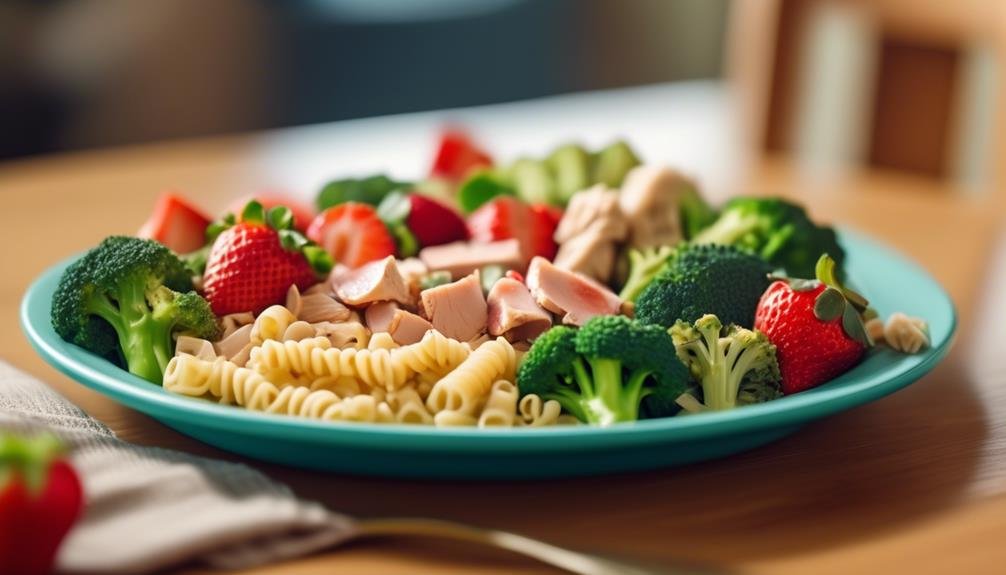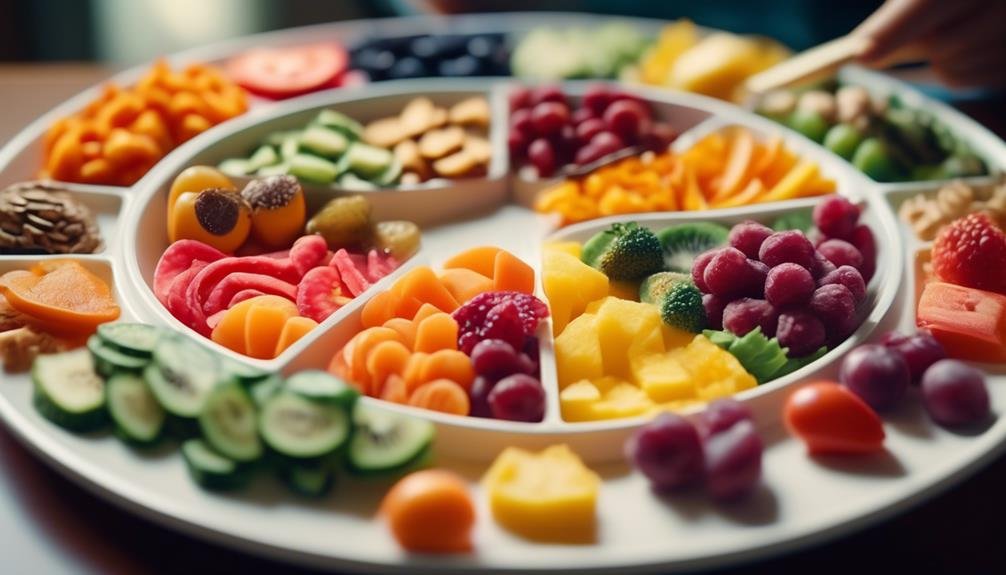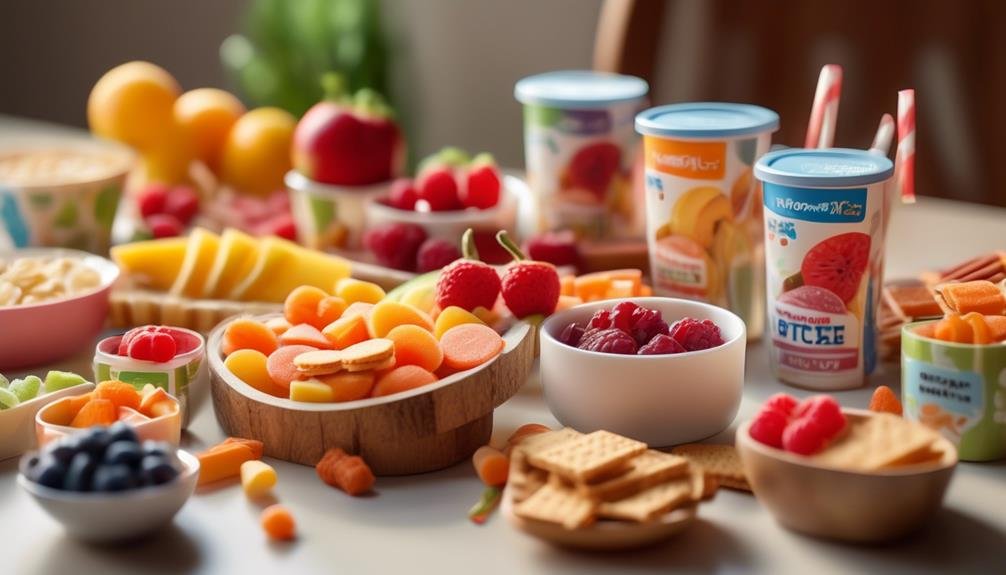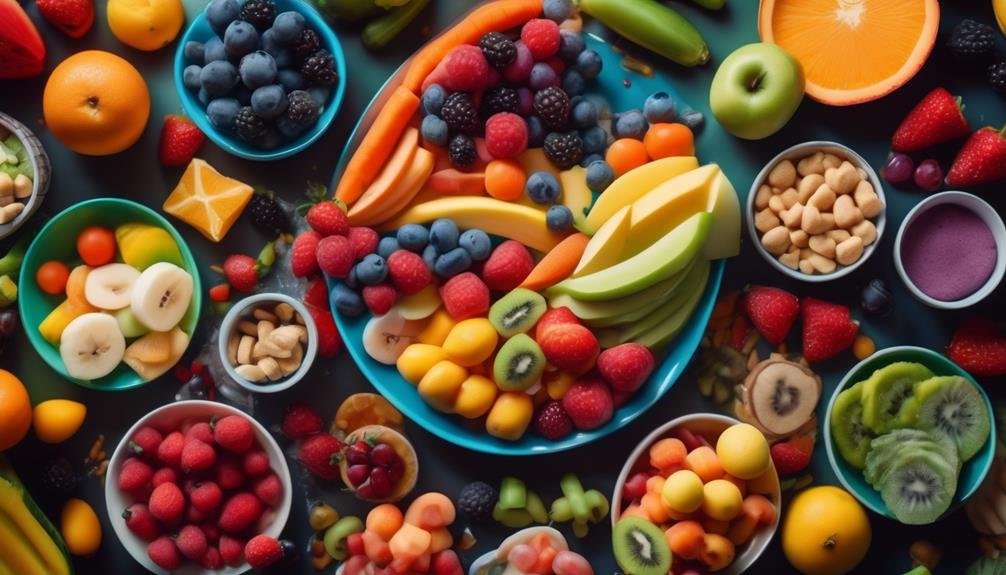"Cherishing Little Steps - A Haven for Baby and Family Journeys"
Toddler Diet at 18 Months
You may think that your toddler's diet at 18 months is just a matter of providing them with basic nutrition, but there's actually a lot more to consider. As your little one grows and develops, their nutritional needs change, and it's important to ensure they're getting the right balance of nutrients to support their growth and development.
In this discussion, we'll explore the various aspects of a toddler's diet at 18 months, from understanding their nutritional needs and food groups to dealing with picky eating and common nutritional pitfalls.
So, if you want to give your toddler the best start in life and ensure they're thriving, then keep reading to discover some valuable insights and tips for their diet at this crucial stage.
Key Takeaways
- Iron, calcium, and omega-3 fatty acids are essential for the development of toddlers at 18 months.
- Good sources of iron include fortified cereals, lean meats, beans, and leafy green vegetables.
- Dairy products, fortified plant-based milk alternatives, tofu, broccoli, and fortified orange juice are good sources of calcium.
- Fatty fish like salmon and trout are excellent sources of omega-3s, and alternatives include flaxseeds, chia seeds, and walnuts.
Nutritional Needs

At 18 months, your toddler has specific nutritional needs that are important for their growth and development. Mealtime struggles and dietary restrictions can make meeting these needs challenging, but with a little planning and creativity, you can ensure your child receives the nutrients they need.
One of the key nutrients your toddler needs at this age is iron. Iron is crucial for brain development and the formation of red blood cells. Good sources of iron include fortified cereals, lean meats, beans, and leafy green vegetables. To enhance iron absorption, pair these foods with vitamin C-rich options like oranges or strawberries.
Calcium is another essential nutrient for your toddler's growing bones and teeth. Dairy products like milk, cheese, and yogurt are excellent sources of calcium. If your child has a dietary restriction or doesn't consume dairy, you can opt for fortified plant-based milk alternatives or include other calcium-rich foods such as tofu, broccoli, and fortified orange juice.
Omega-3 fatty acids are important for brain development and cognitive function. Fatty fish like salmon and trout are excellent sources of omega-3s. If your child doesn't eat fish, you can offer flaxseeds, chia seeds, or walnuts as alternative sources.
Meeting your toddler's nutritional needs may require some creativity, especially if they've dietary restrictions. Consult with a healthcare professional or registered dietitian to ensure your child receives a well-balanced diet that supports their growth and development.
Food Groups
To ensure your toddler's well-balanced diet, it's important to understand the different food groups and how they contribute to their overall nutrition. By incorporating a variety of foods from each group, you can provide your little one with the essential nutrients they need to grow and thrive.
The five main food groups include fruits, vegetables, grains, protein, and dairy. Fruits and vegetables are rich in vitamins, minerals, and fiber, which support your toddler's immune system and digestive health. Grains, such as rice, bread, and pasta, are a great source of energy and provide essential nutrients like iron and B vitamins.
Protein-rich foods like meat, fish, eggs, and legumes are crucial for your toddler's growth and development. They aid in the formation of muscles, tissues, and enzymes. Dairy products like milk, yogurt, and cheese are excellent sources of calcium, which helps build strong bones and teeth.
When planning meals for your toddler, aim for a balance of foods from each group. Include a variety of fruits and vegetables, whole grains, lean proteins, and dairy products. It's also important to consider any food allergies your child may have and make appropriate substitutions or adjustments to their meals.
Portion Sizes

Understanding appropriate portion sizes is essential for ensuring your toddler receives the right amount of food for their age and development. Portion control plays a crucial role in maintaining a healthy diet and preventing overeating. Here are four key points to consider when it comes to portion sizes for your 18-month-old:
- Serve small portions: Toddlers have small stomachs and may not be able to consume large amounts of food in one sitting. Start with small servings and allow your child to ask for more if they're still hungry.
- Pay attention to your toddler's appetite: Every child is different, and their appetite can vary from day to day. It's important to listen to your toddler's hunger cues and adjust portion sizes accordingly. Don't force them to finish their plate if they're full.
- Offer a variety of foods: Providing a balanced meal with different food groups in appropriate portions can help meet your toddler's nutritional needs. Include fruits, vegetables, whole grains, lean proteins, and dairy products in their diet.
- Be mindful of snacks: Snacks can contribute to your toddler's overall calorie intake. Offer healthy snacks in appropriate portions and avoid excessive sugary or processed snacks.
Meal Planning
When planning meals for your 18-month-old, it's important to consider their nutritional needs and portion sizes to ensure they receive a balanced diet. Family meals can be a great way to introduce your toddler to a variety of foods and promote healthy eating habits.
To start with, aim for three meals a day, along with two to three snacks. Include a mix of carbohydrates, proteins, and healthy fats in each meal. Offer a variety of fruits and vegetables, whole grains, lean proteins like chicken or fish, and dairy or dairy alternatives.
To make meal planning easier, consider toddler-friendly recipes that are quick and easy to prepare. Look for recipes that incorporate different food groups and offer a range of flavors and textures. For example, you can try making mini muffins with grated vegetables, whole grain pancakes with mashed fruit, or homemade chicken nuggets with a side of steamed veggies.
Incorporating your child in meal planning and preparation can also make mealtimes more enjoyable and help them develop a positive attitude towards food. Let them choose between two options, offer small portions to avoid overwhelming them, and encourage them to try new foods.
Remember that every child is different, so be patient and flexible as you introduce new foods and flavors to their diet.
Healthy Snack Ideas

For healthy snack ideas for your 18-month-old, consider incorporating a variety of fruits, vegetables, and whole grains into their diet. Here are some tasty recipes and creative presentation ideas to keep snack time interesting and nutritious:
- Fruit kabobs: Thread chunks of different fruits onto skewers for a colorful and fun snack. Try using strawberries, grapes, and pineapple for a tropical twist.
- Veggie muffins: Sneak in some vegetables by adding grated carrots or zucchini to homemade muffins. Your little one won't even notice they're eating their veggies!
- Ants on a log: Spread peanut butter or cream cheese on celery sticks and top with raisins. This classic snack is packed with fiber and protein.
- Mini quesadillas: Fill small whole wheat tortillas with shredded cheese and diced vegetables, then toast until the cheese melts. Cut into bite-sized pieces for little hands.
Remember to offer a variety of snacks throughout the day to ensure your toddler gets a balanced diet. Aim for snacks that are easy to eat, nutrient-dense, and visually appealing.
Introducing New Foods
To introduce new foods to your 18-month-old, offer small portions of a variety of nutritious options to encourage exploration and expand their palate. It's important to be mindful of any potential toddler food allergies when introducing new foods.
Start by introducing one new food at a time and wait a few days before introducing another, to watch for any adverse reactions. Common allergenic foods include peanuts, eggs, milk, wheat, soy, fish, and shellfish.
Offering a variety of textures is also crucial at this stage. As toddlers continue to develop their chewing and swallowing skills, it's important to introduce foods with different textures, such as soft fruits, cooked vegetables, and small pieces of meat. This helps them adapt to different sensations in their mouth and promotes oral motor development.
Remember to cut food into small, bite-sized pieces to prevent choking hazards. By introducing new foods and textures gradually, you can help your toddler develop a diverse and healthy diet while minimizing the risk of allergic reactions.
Dealing With Picky Eating

Encourage your toddler to try a variety of foods to address picky eating habits. Picky eating is a common phase that many toddlers go through, but it can be frustrating for parents. Here are some mealtime strategies that may help:
- Offer a variety of foods: Introduce new foods alongside familiar ones to increase your toddler's exposure to different tastes and textures. Encourage them to take at least one bite of each food.
- Be a role model: Show your toddler that you enjoy eating a variety of foods by eating them yourself. Children are more likely to try new foods when they see their parents eating them.
- Make mealtime enjoyable: Create a positive and relaxed atmosphere during meals. Avoid pressuring your toddler to eat or using food as a reward or punishment. Make mealtimes a pleasant experience for your child.
- Hide vegetables in familiar foods: Sneak in vegetables by blending them into sauces, soups, or smoothies. This can help increase your toddler's nutrient intake without them realizing they're eating vegetables.
Common Nutritional Pitfalls
To ensure your toddler is receiving adequate nutrition, it's important to be aware of common pitfalls that can hinder their diet. Providing balanced meals for your little one is essential for their growth and development. However, there are several nutritional pitfalls that you should be mindful of.
One common pitfall is relying too heavily on processed foods. While convenient, these foods are often high in sodium, preservatives, and unhealthy fats. Instead, focus on offering whole, nutrient-dense foods such as fruits, vegetables, whole grains, lean proteins, and dairy products.
Another pitfall to watch out for is offering sugary drinks. Fruit juices, sodas, and sweetened beverages may seem like a harmless treat, but they can contribute to excessive sugar intake and displace important nutrients from your toddler's diet. It's best to stick with water and milk as the main sources of hydration.
Additionally, be cautious of excessive snacking. While snacks can be a part of a balanced diet, too many snacks throughout the day can lead to a decreased appetite for meals and a potential imbalance in nutrient intake. Limit snacks to one or two small portions per day and offer nutritious options like fruits, vegetables, and whole grain crackers.
Frequently Asked Questions
How Can I Encourage My Toddler to Try New Foods?
You can encourage your toddler to try new foods by offering a variety of options and involving them in meal preparation. Create a positive mealtime environment by setting a good example and providing praise and encouragement for their efforts.
Are There Any Specific Foods That I Should Avoid Giving My 18-Month-Old?
When it comes to your 18-month-old's diet, it's important to steer clear of choking hazards like whole grapes and nuts. Introducing allergenic foods gradually, like eggs and peanuts, can also help reduce the risk of allergies later on.
How Much Milk Should My Toddler Be Drinking at This Age?
You should aim to give your toddler about 16-24 ounces of milk per day at 18 months. Remember to also encourage water intake and provide alternative sources of calcium, like yogurt or cheese.
What Are Some Healthy Snack Options for My 18-Month-Old?
Looking for healthy snack ideas for your 18-month-old? Try offering sliced fruits, yogurt, whole grain crackers, or veggie sticks with hummus. Remember to offer a variety of foods to create a balanced toddler meal plan.
How Can I Ensure That My Toddler Is Getting Enough Iron in Their Diet?
To ensure your toddler gets enough iron in their diet, include iron-rich foods like lean meats, beans, fortified cereals, and green leafy vegetables. Iron deficiency in toddlers can lead to fatigue and developmental delays, so it's important to prioritize iron-rich foods.
Conclusion
In conclusion, ensuring that your toddler receives a balanced diet is essential for their growth and development. By providing a variety of foods from different food groups and considering portion sizes, you can meet their nutritional needs.
Planning meals and incorporating healthy snacks can help maintain their energy levels throughout the day. Introducing new foods and addressing picky eating can be challenging, but with patience and perseverance, you can nurture healthy eating habits.
Avoiding common nutritional pitfalls will contribute to your toddler's overall well-being.


